TikTok is culturally relevant. It may have staying power. But it is not an existential threat to organic search traffic.
Does that mean you should ignore it in your content strategy? Not necessarily.
Social media platforms remain a critical channel for businesses. If your audience spends their digital time on a specific platform, your brand needs a presence.
Enter TikTok. Widely regarded as the world’s fastest emerging social and short-form, mobile video destination, this cultural phenomenon has matured rapidly developing community and business features that are building a foundation for future brand investment.
What differentiates it from other social media networks? Its impossibly strong discovery algorithm and “For You” page have captivated people across the world and fulfilled an entertainment and social place among a range of demographics and geographies.
What makes TikTok unique?
The TikTok For You page has become, arguably, the most popular source of endless entertainment.
It’s where you find all the videos that seem tailor-made for you, from hilarious skits to helpful tutorials. Unlike platforms where you primarily see content from people you follow, TikTok’s For You page introduces you to content from creators you might not even know exist, based on what you have previously liked or watched. This means you’re constantly discovering fresh and diverse content that aligns with your interests, expanding your horizons with every scroll.
Powered by the infamously strong algorithm, the For You page helps TikTok learn from your interactions to serve up content that’s not only entertaining but also highly relevant to you, so it’s like having your own personal comedian, chef, and dance instructor all rolled into one addictive app.
Initially launched as Musical.ly in 2016, the app originally catered to a younger creator demographic. They used it as a fun way to showcase short dance routines or lip-sync to their favorite songs. It was harmless and mindless. Traction among pre-teens, teenagers, and young adults escalated quickly.

In 2018, Chinese tech company, ByteDance, acquired Musical.ly and merged it with its video app, TikTok. Result: a relatively seamless global rebranding effort.
While it maintained its genetic presence in the music and dancing world, it would soon expand exponentially across every niche and industry. Now it’s considered a direct YouTube competitor. Creators and influencers saw their exposure and visibility explode. Incentivized with new content formats, they filled a short video content gap online.
Where did TikTok emerge from?
TikTok’s evolution from Musical.ly wasn’t just a name change—it was a defining shift in social media’s landscape.
From 2017-2022, growth sprung from groundbreaking features like an algorithm that dishes out a relentless flow of tailored content, alongside a user-friendly video toolkit that leveraged in-app editing and immediate uploads.
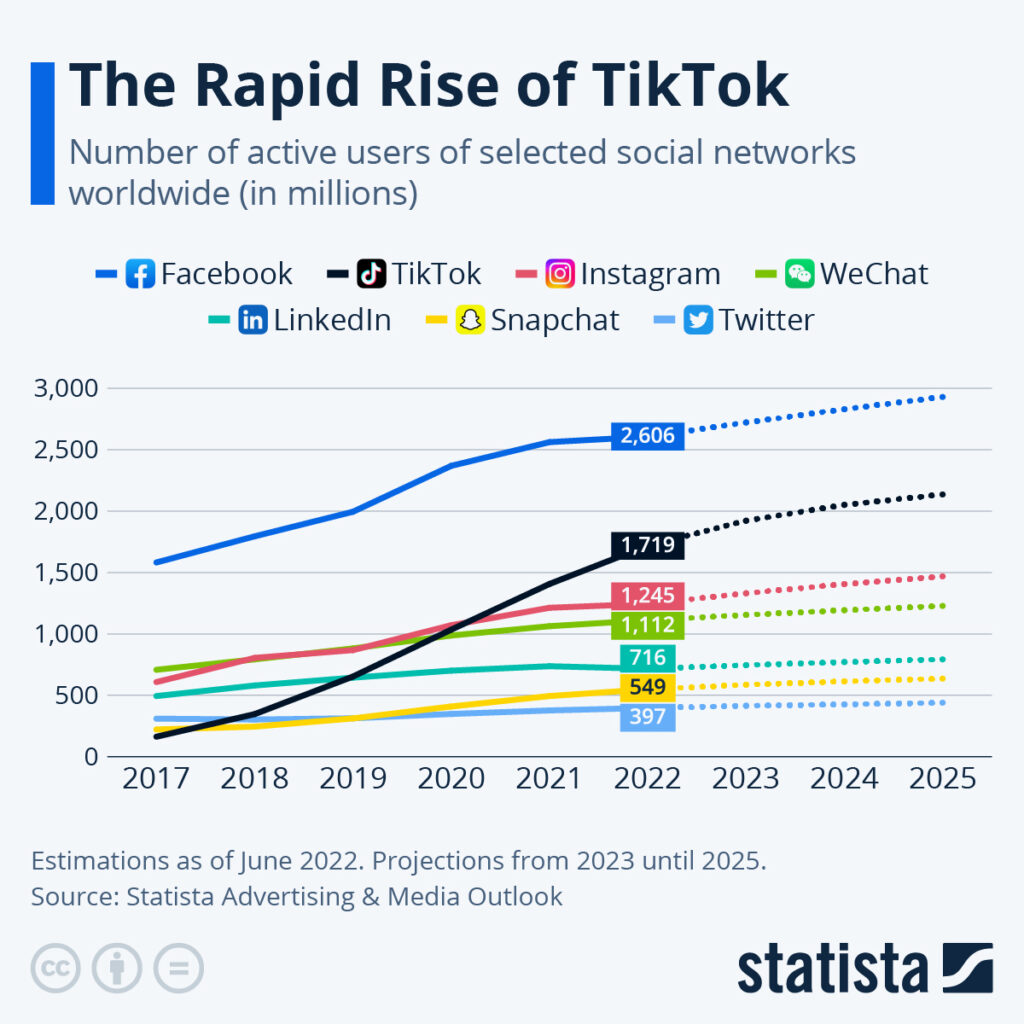
TikTok’s success taps into modern social media habits, where instant gratification and dopamine hits drive usage. Its effectiveness lies in delivering these through personalized content that keeps users coming back for more, making it a standout as people craze instant connection and endless entertainment.
TikTok’s Shocking Reach
As of January 2024, TikTok boasts over 1.5 billion active monthly users worldwide, cementing its status as one of the most popular social media platforms globally.
Its user and creator base spans across demographics, with a particularly strong presence among Gen Z and millennial audiences. The platform’s influence now extends beyond entertainment, shaping cultural trends, growing enterprise and personal brands, and driving conversations on a global scale.
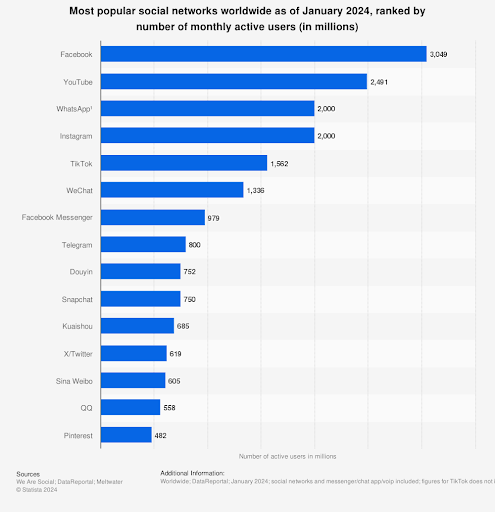
Businesses can’t afford to overlook TikTok’s significance in today’s digital social ecosystem. Whether you’re a local brick-and-mortar establishment or a multinational corporation, TikTok presents unparalleled opportunities for audience engagement and brand visibility.
TikTok’s Power in Action
Brands from around the globe have seen what TikTok’s reach can do for their business. From small e-commerce brands to global conglomerates, TikTok has begun to play a pivotal role in brand growth and awareness.
One such brand, which by chance benefited from TikTok’s reach, is The Pink Stuff. Once sparsely known and sold at only a couple of retail chains throughout Britain, The Pink Stuff brand has quadrupled its sales since 2018 thanks to one cleaning influencer who happened to enjoy the product and posted about its cleaning ability on her Instagram. Funny enough, Sophie Hinchliffe, the influencer, didn’t even have a TikTok at the time, but her followers brought it onto the platform and the once barely known product had swept across the world.
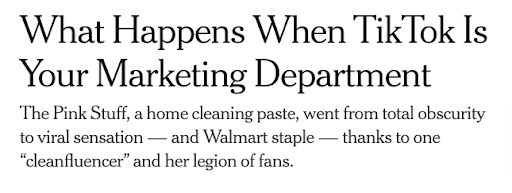
Educational Insights, a toy brand, also capitalized on TikTok’s reach being one of the first to test the platform’s e-commerce features, TikTok Shop. The brand took advantage of the early testing period that began in early 2023 and saw a 300%-400% MoM increase in sales before plateauing at a much higher benchmark as the year went on. To continue that early success, Education Insights planned its biggest livestream shopping event on TikTok Live as a promotional tool for Black Friday and Cyber Monday sales. A strategy that many brands, including names like Best Buy, are utilizing to capture customers in a different way.
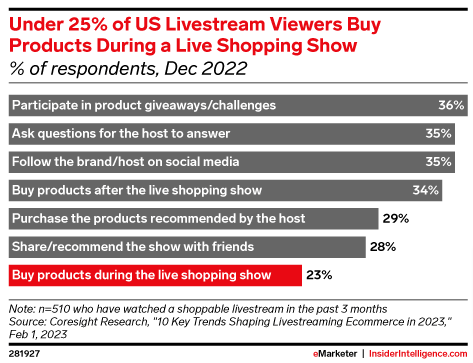
TikTok: A Hub for Innovative Marketing
Marketing (and advertising) on TikTok has emerged as a legitimate consideration for a variety of business types in all industries, offering brands a dynamic channel to connect with audiences in authentic and creative ways.
The fitness sector has exploded in the TikTok space with countless influencers and brands working together to showcase their products in the gym and on models. One shining example is GymShark, a gym apparel brand. Using both traditional and non-traditional fitness content, GymShark reached 2 million followers in only six months on the platform. They post everything from workout challenges to gym humor, and launched their own 66 Days: Change Your Life challenge that offered a GymShark membership for those who posted their fitness journey.
@gymshark Expectation vs reality 😂 @jonnyhammond__ #gymshark #running #runningmeme ♬ original sound - Gymshark
@dunkin So official, we put it in writing @charlidamelio. Order ‘The Charli’ on the Dunkin’ app!🙌 #CharliRunsOnDunkin #TheCharli #Dunkin ♬ original sound - Dunkin'
The food/restaurant sector has also seen massive success on the platform with the ability to use influencers to promote and show off their food items. Dunkin’ has shown what brands in the restaurant industry can do on TikTok by partnering with one of the biggest TikTok stars Charli D’Amelio who videos herself getting Dunkin’ and telling her followers what she gets. The partnership has resulted in new menu items being launched, and subsequently, a 57% jump in Dunkin’ app downloads and a 20% increase in sales of cold brew coffee.
Whether using paid ads, influencers to promote products, or simply showing users how their services work, brands, and individuals from every industry have turned TikTok into an all-encompassing marketing platform to reach millions.
Let’s explore how leveraging TikTok’s diverse set of tools and strategies can drive impactful results and foster brand growth.
Empowering Brands with Business-Friendly Tools
TikTok empowers social media marketers to craft compelling campaigns and engage with audiences on a deeper level.
For eCommerce brands, the TikTok Shop provides a mechanism for businesses to showcase products directly within the platform, facilitating a frictionless purchasing experience. Features like:
- LIVE Shopping
- Shoppable Videos
- Featured Product Options
- Affiliate Programs
- Shop Ads
- TikTok Fulfillment
- Secure Checkout Process
- Shop Tab
- Shop Pages
They allow brands full control of their audiences’ shopping experience to drive conversions and reach a wider audience.
These features are huge for e-commerce brands seeking to leverage short product videos and influencers to drive conversions. The buying process now includes research via TikTok for a large demographic of buyers.
One brand that has done a great job taking advantage of the Shop’s features is Pacsun. The clothing brand has a fully built-out Shop page, utilizes LIVE shopping sessions, and has a complete checkout experience through TikTok so users don’t even have to leave the app to make a purchase.
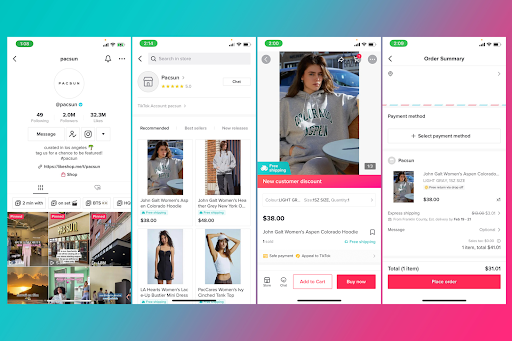
The optimized shopping experience has helped their 2M+ followers and multiple viral campaigns, such as the #DoPacSun campaign, convert billions of views into purchases and has become a staple for the business. Due to their success, they have even created a TikTok page on their main domain for the many followers looking for outfits that have been showcased on their TikTok page.
55% of total consumers and 87% of Gen Z consumers use and prefer video content when looking for products according to Hubspot. Incorporating video into any e-commerce and service marketing strategy is an absolute must, especially if your target audience falls within the younger generations.
@avani @pacsun and i wanna see your transitions too 🙂 #DoPacSun #ad ♬ Hit ‘Em With That! - Pacsun
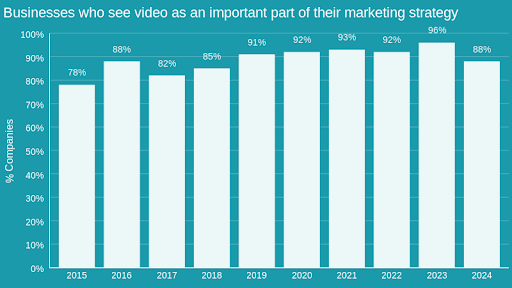
In addition to a powerful e-commerce integration, TikTok recently rolled out a robust analytics dashboard with invaluable insights into campaign performance, allowing for a data-driven social media strategy.
With the ability to evaluate and adjust performance metrics, brands can understand what’s effective for their audience and use that information in other channels.
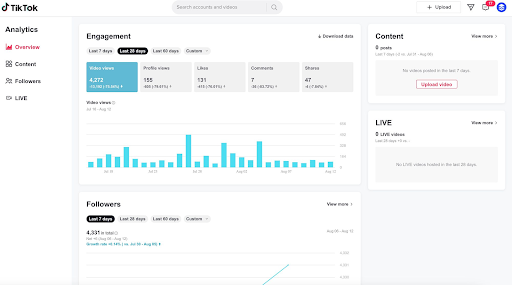
Beyond organic reporting, TikTok’s advertising platform offers a range of ad formats tailored to diverse campaign objectives, ensuring brands can effectively reach their target audience with precision.
- In-Feed Ads – Sponsored content that shows up in a user’s feed as a typical video, with the ability to enhance with add-ons like a “Shop now” button
- TopView Ads – Ads that will pop up as the first thing a user sees when they open the app
- Crowdsourcing – With hashtags, invite creators to create branded content and pick the top-performing videos to boost as ads
- Branded Effect – Create your own branded video effect that creators can use in their videos
- Spark Ads – Use organically made videos that mention your brand for your advertising efforts
- Promote – Promote your already created internal content in a few clicks
TikTok ads empower marketers to optimize their campaigns for maximum impact, ensuring their message resonates with the right audience at the right time.
Harnessing the Power of Influencer and Affiliate Partnerships
Influencer marketing still lacks standardization.
- What are appropriate rates?
- What creatives can be produced?
- What deliverables should we expect?
It’s difficult to justify investment with so much uncertainty.
On TikTok, influencer and affiliate marketing have emerged as more mature and potent strategies, leveraging the platform’s emphasis on authenticity and relatability. By collaborating with influencers, brands can tap into their follower base and utilize social proof to convert users. Whether it’s endorsing a product’s features or showcasing a service and the finished result, influencers and affiliates play a pivotal role in driving consumer trust and engagement.
Finding suitable influencers has become easier than ever with TikTok’s creative Partner Discovery which allows you to sift through creators in your sector to find the perfect partner for your brand.
Navigating the Landscape: Enterprise vs. Local/Personal Brands
The approach to TikTok marketing varies significantly between enterprise-level corporations and local or personal brands. While large enterprises leverage TikTok’s expansive reach and resources to execute high-budget campaigns, smaller brands capitalize on the platform’s community-driven nature to foster genuine connections with niche audiences.
Take, for instance, a global giant like Red Bull, which leverages TikTok’s creative capabilities to launch viral campaigns and engage with millions of users worldwide. They know exactly who they are trying to reach, and do so with fast-paced, action-packed content that has garnered a 10% engagement rate, while the average is around 2-4% according to a Social Insider survey.
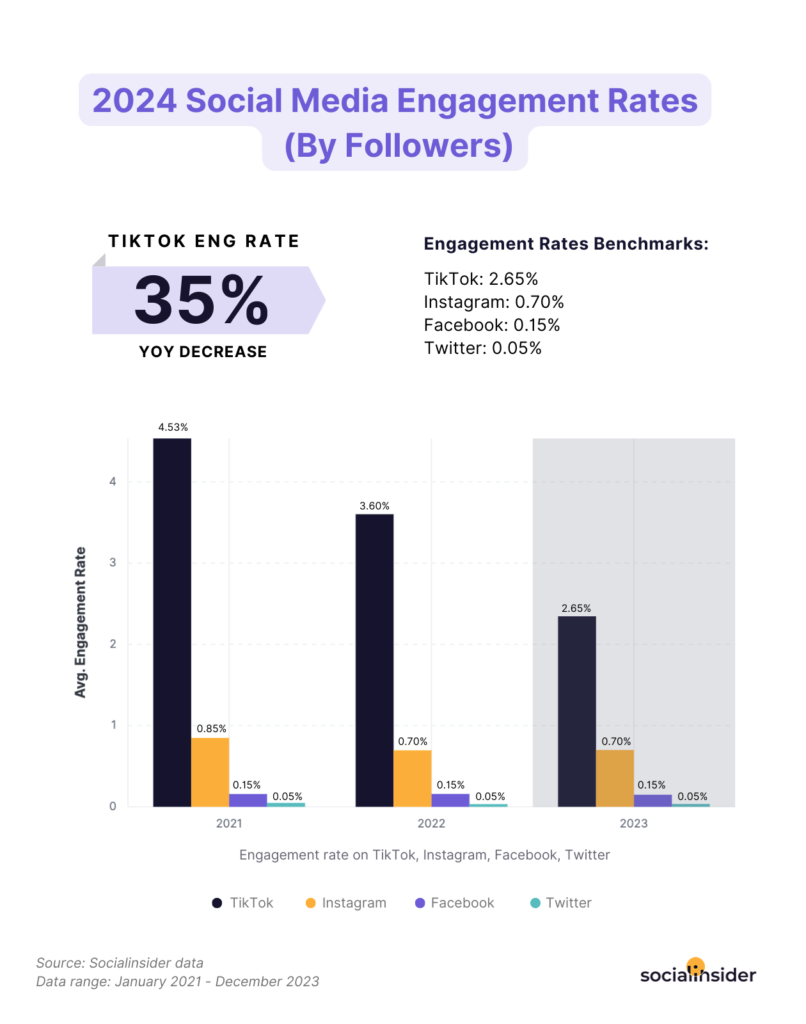
Conversely, neighborhood cafes and boutique stores effectively utilize TikTok to showcase their unique offerings and connect with local communities on a personal level. TikTok serves as a dynamic playground for both large and small marketing teams to experiment with innovative strategies and connect with audiences in meaningful ways. By leveraging the platform’s diverse set of tools and understanding the nuances of TikTok marketing, businesses can unlock new avenues for both paid and organic growth.
How Does This All Relate to Search?
Recently, journalistic thought pieces have made the argument that TikTok has become a Google replacement for teenagers and young adults. They argue that the social media channel is replacing the traditional search engine.
The maturation of the platform along with the investment and attention from major brands legitimizes those claims. Even Google itself has included TikTok videos in its search results more frequently.
But has it established itself to the extent that Enterprise brands and category leaders need to position themselves to be found for TikTok searches?
Regardless, the volume of participation speaks for itself. Businesses can unlock new pathways to organic search success. Brands can learn to better understand their audience, create valuable assets that will drive conversions, and use TikTok to complement their traditional Google-focused SEO strategies.
TikTok as a Search Engine
Highly personalized content and refined target marketing have transcended TikTok from its initial identity as a mere entertainment hub, to a dynamic search engine for its vast user base who look for product information, services, and advice. More and more, users turn to TikTok for answers to their questions and help with purchasing decisions. While it is not going to be Google anytime soon, or likely, ever, its impact on search and search behavior cannot be dismissed.
User Behavior on TikTok
Understanding user behavior on TikTok is crucial for businesses looking to harness its potential as a search engine. Much like traditional search engines or social platforms, users turn to TikTok with specific intentions, whether it’s seeking entertainment, information, or inspiration, and they do so seeking the closer connection to influencers and searches that TikTok offers.
What sets TikTok search apart from giants like Instagram, for example, is its highly interactive nature and focus on connection, which prompts users to engage with content in a more immersive manner by stitching or dueting a video for example. A stitch and/or duet is a video response from one creator to another and allows users to directly respond and interact with influencers via video. This highly interactive and community-focused nature has led users on TikTok to search for brands through their favorite influencers, showing the importance of a strong partnership between a brand and an influencer in their niche.
This trend has played an especially big role for e-commerce brands using influencers and affiliates as users begin to search for a product or service through the influencer who introduced them to it. What we often see happen now is a user will watch their favorite TikToker use a product in their own lives and after seeing what the product can do and hearing someone they admire sing its praise, they will either click a direct link to purchase or take to Google to find the product and convert. This could likely lead to an increased importance in branded searchability for brands.
Now over half, and reportedly up to 75% of Gen Z prefers TikTok as their #1 search engine according to a 2023 Her Campus media study, and purchase products/services based on what they saw on TikTok.

Comparing TikTok search behavior to that of Google reveals fascinating insights into user intent and engagement. While Google searches often prioritize textual queries, TikTok users tend to look for visual and audio content based on a hashtag, brand name, or influencer name, to instantly find content that captivates their attention within seconds. This shift favors the platform’s emphasis on creativity and brevity as key drivers of user engagement and should be duly noted in search optimization efforts. Nonetheless, the importance of informational queries on TikTok should not be lost on brands (more on that in a second).
Short Form Videos and Search
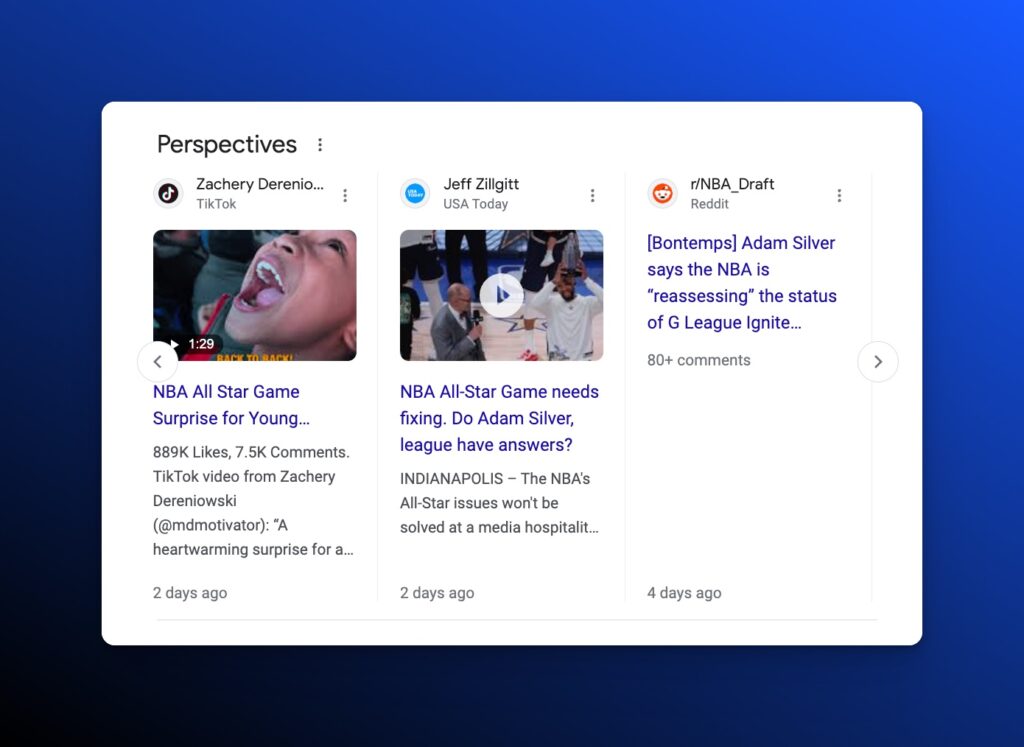
TikTok-style content as a whole presents a challenge to traditional search engines as users are looking for video results as opposed to the article/blog type results currently abundant in the SERPs. And capitalizing on this video trend, amongst many other big names in social media and search, is Youtube. YouTube’s “Shorts”, YouTube’s response to TikTok and Instagram Reels, are a notable player in the game and should not be unaccounted for with YouTube being one of the OG social search engines with over 2 billion monthly active users.
Distinguishing between the format and use behavior of TikTok and YouTube shorts offers valuable insights into the evolving landscape of short-form video content. While both platforms cater to brief, engaging content experiences, YouTube Shorts still appears to cater specifically to entertainment and lacks the social interaction offered by TikTok, while TikTok’s business integrations and emphasis on user engagement set it apart as a formidable contender in the search engine arena.
TikTok's Threat to Traditional Search
The rise of TikTok as a search engine poses a significant challenge, notice, not a threat, to traditional search platforms like Google; the challenge being the shift in preference for short-video content and the ability to purchase directly from the platform. Google should not necessarily be concerned about the trend towards TikTok, and TikTok-style, content, but they do need to adapt to meet the needs of their users, otherwise, a true threat could present itself.
As discussed, while TikTok search is more focused on short, brand/influencer-focused searches, users across generations are beginning to turn to TikTok for many queries, in fact, Rise At Seven, one of the first agencies to conduct a study on the impact of TikTok on search, found that 40% of Gen Z prefers TikTok for informational searches and popular queries have a drastically higher search volume on TikTok over Google.
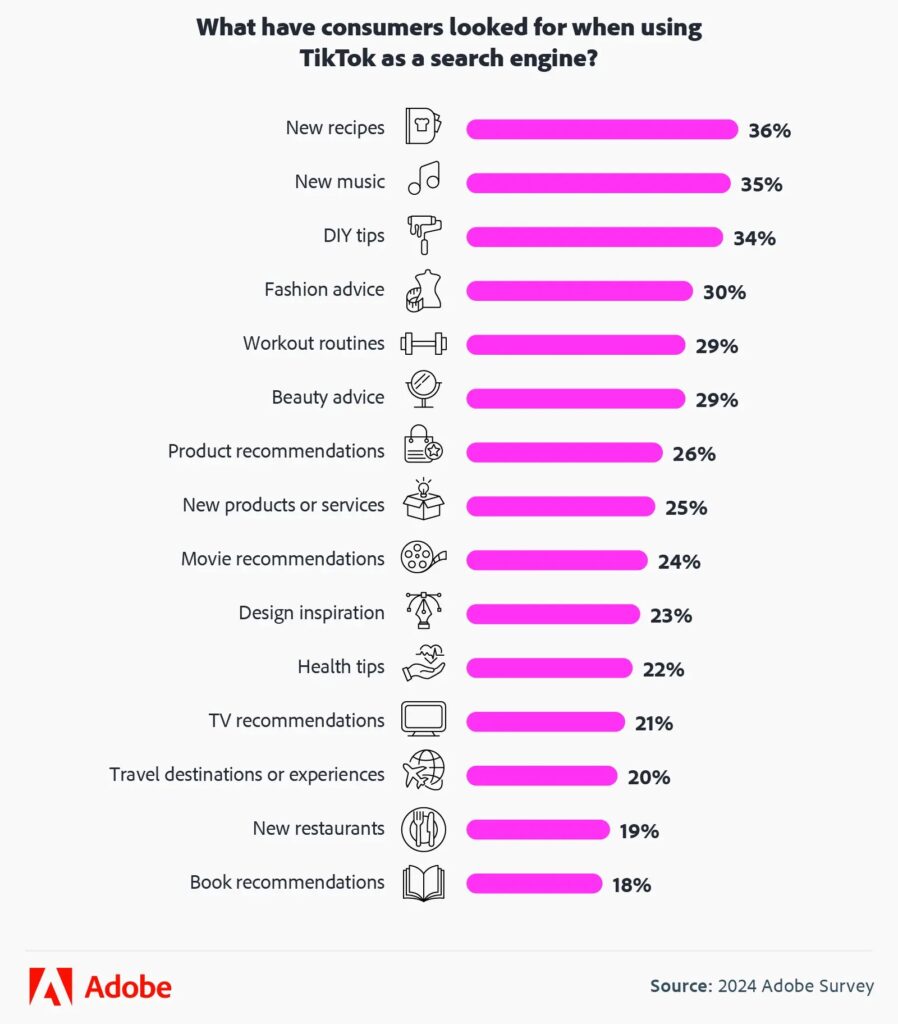
Examples of Search Journeys:
New Recipe:
1. See the food influencer briefly run through preparation and show the final result (which always looks irresistible)
2a. Click the link from the caption on the recipe page/site
2b. Search for the recipe on Google (Ex. “TikTok burger recipe”)
2c. Search for the recipe on TikTok (Ex. “burger recipe”)
3. See products to create the recipe
4. Buy Products
Local Search – Restaurants in Orlando
1a. Search for “best food in Orlando” on TikTok
1b. Organically see a video of food from a restaurant or review from an influencer page
2. Search the restaurant on TikTok for reviews or videos of menu items/atmosphere
3. Search for reviews on Google
4. Visit restaurant
TikTok is driving traffic to Google and we are seeing Google searches becoming increasingly supplanted by TikTok-centric queries, reflecting a shift in the origin of brand awareness and user preferences towards more visual, interactive content experiences.
Moz’s Keyword Explorer even reports almost 500K monthly searches for TikTok branded queries alone; if Google and businesses without a TikTok presence don’t prioritize answering those queries themselves, they will continue to lose users to TikTok. As users increasingly turn to TikTok for entertainment and information, businesses and content creators must adapt their SEO strategies to capitalize on this short-form video trend.
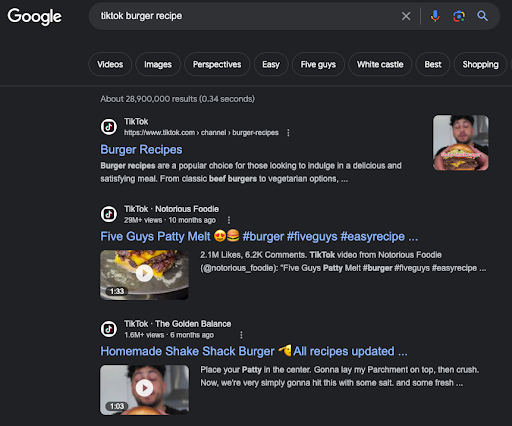

These TikTok branded searches are, naturally, resulting in TikTok content, and ranking a third-party site in the mix is difficult, but nonetheless, possible. While challenging for brands, this should present an opportunity to create TikTok content that is supplemented with, and connected to, on-site content to increase authority and visibility for both mediums.
How Brands Can Optimize Search Around TikTok
TikTok’s emergence as a search engine has no doubt revolutionized user behavior, reshaping how individuals discover content and engage with brands. The change presents both opportunities and challenges for businesses looking to maximize their online visibility and reach.
Brand Strategy: A Blueprint for Success
Staying up-to-date with TikTok trends is paramount for businesses to maintain relevance and resonate with their target audience.
You can stay updated on trends by:
- Visiting the TikTok search page
- Looking around the TikTok Creative Center
- Doing a Spotify search for “TikTok” or visiting TikTok’s Playlist
- Checking this Later blog on the weekly TikTok trends
By aligning their content strategies with prevailing TikTok trends and internally creating TikTok content to live on their site and profile, businesses can position themselves at the forefront of cultural conversations, driving engagement and fostering brand affinity.
One way brands can do so is to actually do a TikTok search for either the brand name or the product/service the brand offers to see what or who is pulling up. This will help your brand determine what content needs to be created or which creator to partner with for you to be successful in this space. Carefully evaluate if you can replicate what users are looking for and incorporate this into your organic strategy.
While there are many approaches and considerations to take when looking into the efficacy of search on TikTok, one thing is certain; do not fall behind!
An Adobe survey of over 250 business owners found that 54% of them are already using TikTok to market their brand and the number is only going to climb. Whatever your niche, whatever your industry, there is an audience to reach on TikTok and you need to consider adopting a nuanced approach that aligns with your target audience and business objectives. Take into account your business and goals and determine if TikTok is a worthy investment for your search efforts.
Understanding the demographics and interests of TikTok users, and more specifically your target audience, is crucial for crafting content that resonates authentically and drives meaningful engagement. While TikTok presents unparalleled opportunities for brand visibility, it’s essential to evaluate the platform’s alignment with your overarching marketing strategy and allocate resources accordingly.
TikTok's Relevance for Certain Industries
Industries such as fashion, beauty, and entertainment, which thrive on visual storytelling and consumer engagement, stand to benefit immensely from TikTok’s immersive and interactive platform.
Less obvious sectors such as food, local services, and even finance also stand to benefit from the rapid rise in search on TikTok with the ability to showcase mouth-watering food or share general financial advice based on personal experience. Oddly enough, a Vericast survey found that 34% of Gen Z looks for financial advice from TikTok with finance influencers like Tori Dunlap and Kenny Finance being at the top of the game with 2 and 9 million followers respectively.
Moreover, brands catering to younger demographics, including Gen Z and Gen Alpha, can leverage TikTok’s popularity and cultural relevance to establish meaningful connections and drive brand affinity. Understanding TikTok’s impact on user behavior and industry trends is paramount for enterprises looking to harness its potential for strategic outreach and sustainable growth.
Leveraging TikTok SEO Strategies on Your Websites
For those who see a potential path forward and an alignment with your target audience, incorporating TikTok SEO strategies into your website can further enhance your brand’s online presence and search visibility on both TikTok and Google. By optimizing website content with relevant keywords, hashtags, and trending topics from TikTok, you can improve the brand’s chances of appearing in search results and driving organic traffic.
Additionally, embedding TikTok videos or user-generated content on your website can enrich the user experience and bolster engagement, further signaling relevance to search engines. By integrating TikTok SEO seamlessly into your broader digital marketing strategy, businesses can unlock new avenues for growth and establish a strong foothold in the competitive online landscape.
One brand using this strategy well is Zazzle, an e-commerce brand that focuses on custom products, cards, and events. On their category pages, they feature a carousel of TikToks and other short videos from their customer base, along with their own team, showcasing product examples and sharing reviews. With cross-platform integration and keyword targeting, these Zazzle videos can become more visible on TikTok and within the Google suggested videos, which is increasingly featuring TikTok videos, as they become more relevant with targeted keywords.
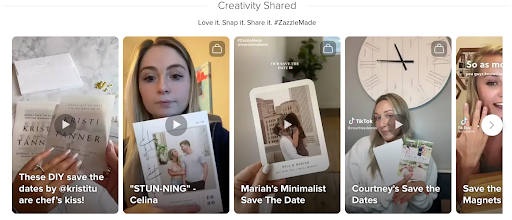
Overall, optimizing search around TikTok necessitates a strategic and data-driven approach that prioritizes alignment with prevailing trends, understanding of the target audience, and seamless integration of TikTok SEO strategies into broader marketing initiatives. By embracing TikTok’s search potential and utilizing its features, businesses can elevate their brand visibility and traffic.
The Future of Search with TikTok
As businesses continue to adapt to the ever-evolving world of search, TikTok’s efforts to evolve as a search engine pose profound implications for the future of search behavior and marketing strategies. There is no doubt that understanding the platform’s evolving functionalities and its relevance across various industries is essential for enterprises seeking to stay ahead of the curve. Search and TikTok are going to continue changing so staying in tune will be crucial for future success.
TikTok's Evolving Search Functionality
TikTok’s relentless pursuit of search innovation should be closely followed by every small and enterprise-sized business. From algorithmic enhancements to personalized content recommendations, TikTok is continually refining its search functionalities to deliver unparalleled user experiences and facilitate seamless content discovery with features like comment interlinking, allowing users to click into video tags or categories directly from a comment.
tiktok is testing a new feature identifying key words in comments and linking to search results for them pic.twitter.com/7dRQMoV4Pk
— Olivia Deng (@oliviadng_) August 5, 2022
X user Olivia Deng showing how this comment interlinking works.
Hyperlinked words in comments can also appear at the top of comment sections allowing for even quicker access to related content.
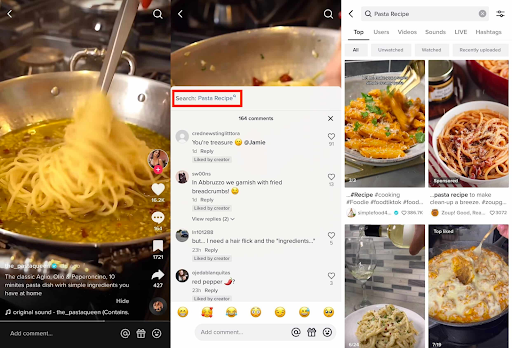
Example from a post by The Pasta Queen.
Also, the integration of advanced search features such as suggested search and featured snippets, powered by WikiHow, signals its intent to solidify its position as a dominant force in the digital search ecosystem.
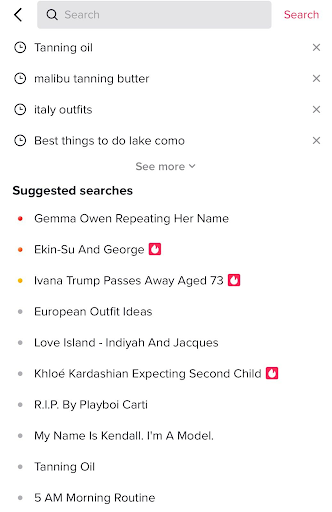
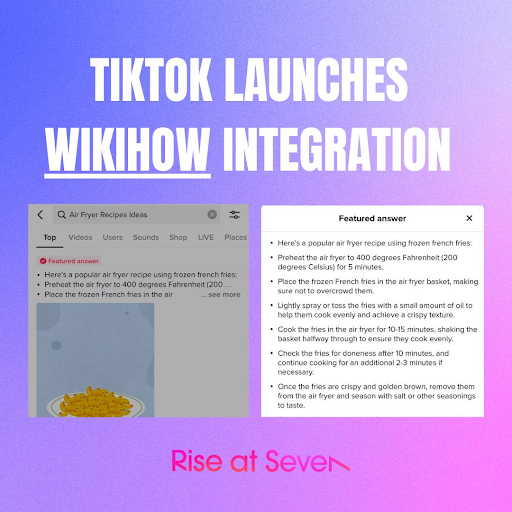
The future of search with TikTok hinges on its continued evolution as a dynamic and innovative search engine. By embracing TikTok’s evolving functionalities and understanding its relevance across various industries, enterprises can position themselves for success in the digital landscape of tomorrow, driving tangible results and fostering long-term brand growth.
Final Words on TikTok as a Search Engine
TikTok, once primarily known for its entertaining short-form videos, has evolved into a multifaceted platform that continues to function more like a search engine than a traditional social media app. This transformation stems from its powerful algorithm, enormous user base, and continued efforts to enhance its search functionality.
While TikTok is not going to replace Google by any stretch of the imagination, the change in search behavior across every demographic has altered not only the way Google needs to deliver results, but the strategies businesses use to organically reach their target audience.
As TikTok’s evolution continues, brands will need to adjust if they want to capitalize on the opportunity of reaching more users and driving more revenue.
Next Steps
Here are 3 ways iPullRank can help you combine SEO and content to earn visibility for your business and drive revenue:
- Schedule a 30-Minute Strategy Session: Share your biggest SEO and content challenges so we can put together a custom discovery deck after looking through your digital presence. No one-size-fits-all solutions, only tailored advice to grow your business. Schedule your consultation session now.
- Mitigate the AI Overviews’ Potential Impact: How prepared is your SEO strategy for Google’s AI Overviews? Get ahead of potential threats and ensure your site remains competitive with our comprehensive AI Overviews Threat Report. Get your AI Overviews report.
- Enhance Your Content Relevancy with Orbitwise: Not sure if your content is mathematically relevant? Use Orbitwise to test and improve your content’s relevancy, ensuring it ranks for your targeted keywords. Test your content relevance today.
Want more? Visit our Resources Page for access to past webinars, exclusive guides, and insightful blogs crafted by our team of experts.
- Exploring TikTok’s Potential as a Complementary Force to Google Search - February 22, 2024

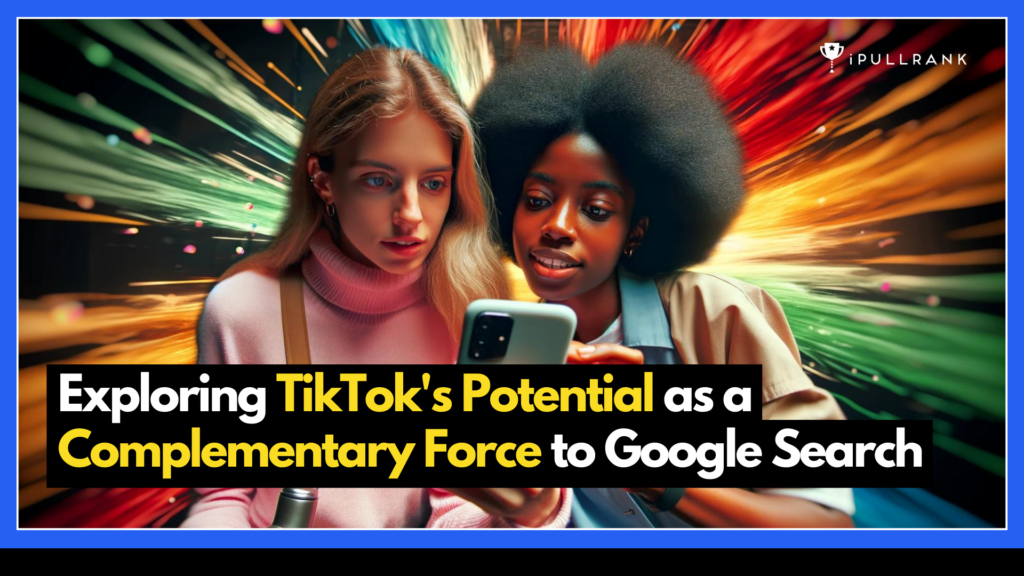
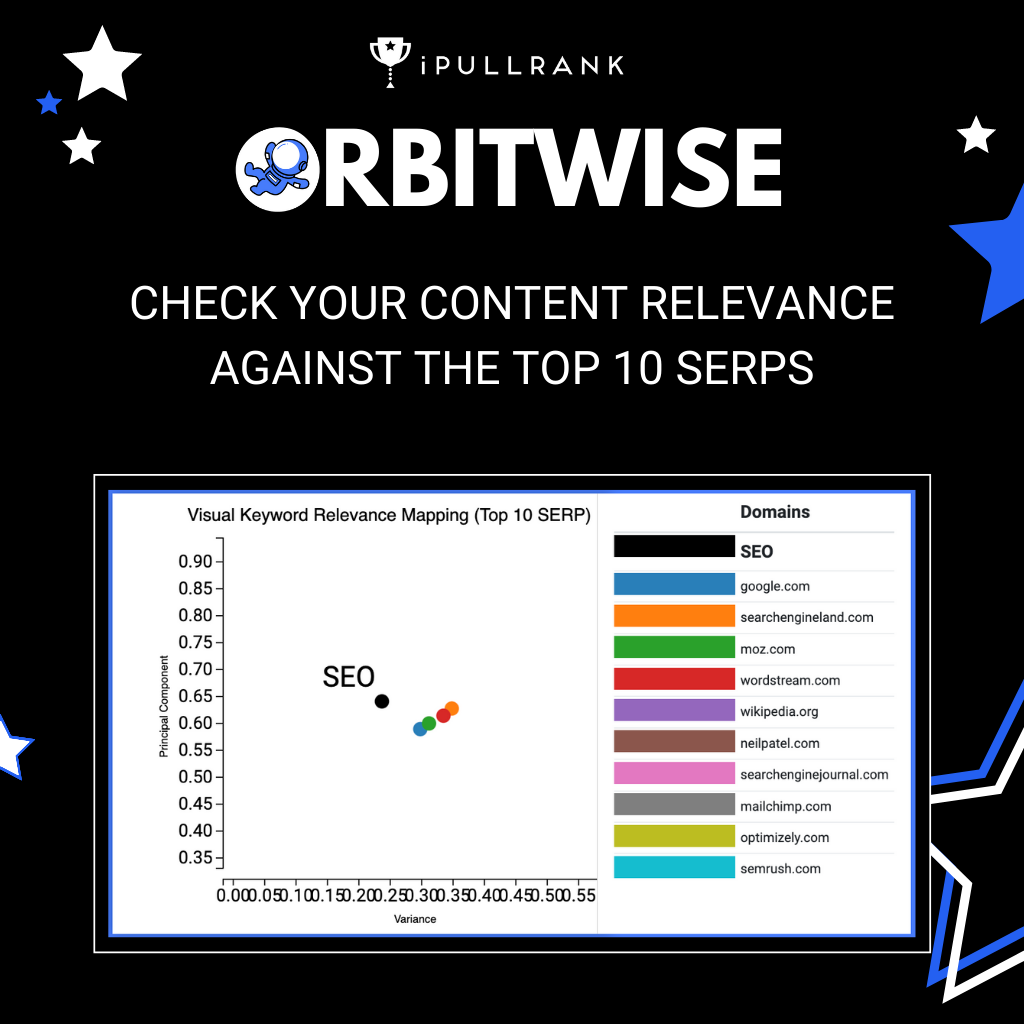


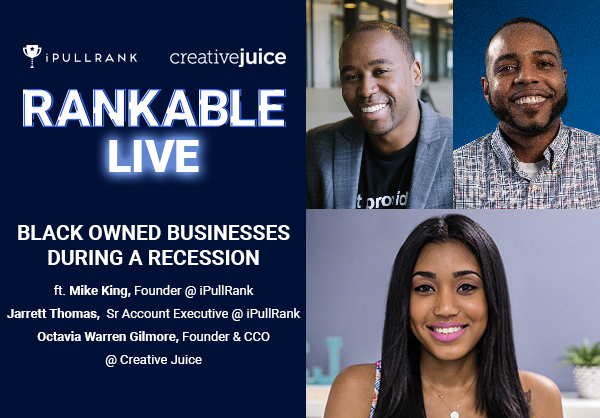





Leave a Comment